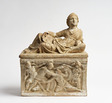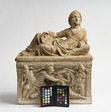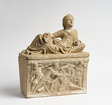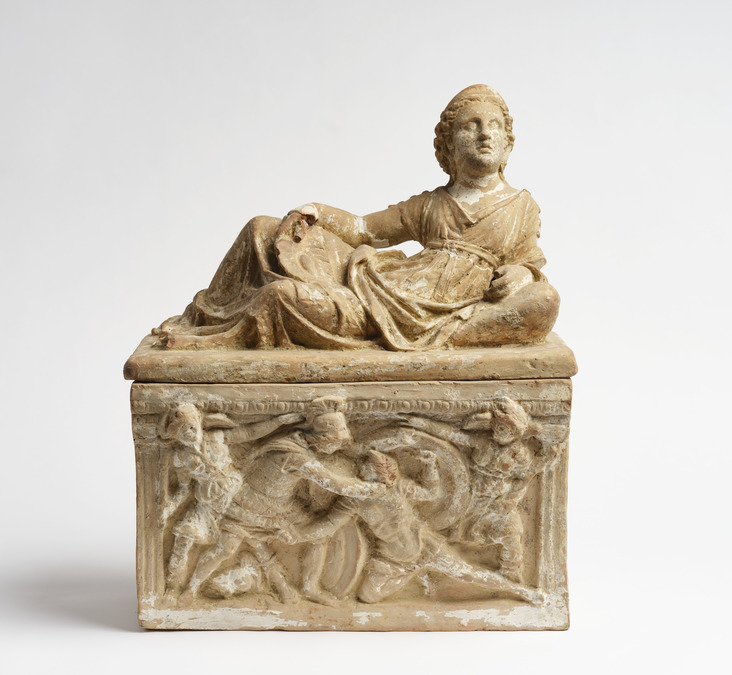Cinerary Urn
Summary
The scene on the sides of the urn are very similar to those seen in 38/516, another item from the Glyptotek collection. They depict the double-death scene of Polyneikes and Eteocles from Greek tragedy, although the swords held by either man cannot be seen. On the lid, a female figure reclines, in the same position as the other cinerary urns.
Description of object
On the lid is a female figure in the same position as on the other cinerary urn in the collection (39 – HIN 171.) There is one exception – the head is turned more towards the right. The face is both conventional and idealised; the wavy hair as a centre parting, and the thick hair at the sides is gathered into a bun at the neck, while two long curls fall over the shoulders. The only jewellery is a diadem with volute-ornamentation, and pendant earrings. The chiton has buttons along the shoulder-seams and a knotted fringe belt under the bust. The himation is nearly ankle-length and under it the folds of the chiton can be seen. The pronounced folds of the garment corresponded to those of the main in the proceeding piece (see the reference above.)
The left hand is holding a downturned fan, which has feathers attached to an almond-shaped centre-piece. The left hand is resting on a thick cushion, while the bare toes can be seen over the left edge. The modelling is done in a highly plastic, also on the rear side. The urn is similar to others in the Glyptotek collection, but is described as having a more trapezoidal profile.
The lid-figrure’s right arm and left forearm have been broken off but have been replaced; the left thumb is missing. The clay is light beige with a finer levigated surface and remains of a cream-coloured slip. The figure has a flat underside, but inside it is hollow; there is an air-hole in the left armpit. The urn’s mould was slightly more worn than that of other examples in the Glyptotek’s collection, and the details of the relief have been touched up with a modelling-tool. The top has rounded corners. The clay is red-brownish with a light red-beige surface covered with white primer colour. On acquisition, many colours were noted, but now there is only a little red on the hair of the second figure from the right: this is due to the heavy-handed washing the piece received as an attempt to detect a forgery. Whenever colours are applied after firing, they will not survive such treatment and the urn has been unjustly regarded as a fake.
Lid, H: 28.3 cm.; W: 22.3 cm.; L: 45 cm.
Urn, H: 26 cm.; W: 23 cm at the top, 17.5 cm at the base.; L: 43.3 cm.
Choice of methods
Visual examination
- Macroscopic
Technical imaging
- UV
- VIL
- IR
Sampling
- XRF
- FT-IR
- UV-VIS
- Raman
Bibliography
Den Entruskiske samling, H. 305.
Gempeler, Werke der Antike 58 (where the lid is compared to Zurich inv. 1964/11) C.f. also_ Artigianato Artistico_, particularly no. 120, where the hair is arranged slightly differently
Modonesi, Museo Maffeiano, no. 24. where the face is turned to the left.
- HIN 102
- Statue
- c. 150 - 130 BC
- Roman Republican
- Terracotta
- Acquired in 1896 by Carl Jacobsen's at Pacini's in Florence.
- Lid, H: 28.3 cm.; W: 22.3 cm.; L: 45 cm. Urn, H: 26 cm.; W: 23 cm at the top, 17.5 cm at the base.; L: 43.3 cm.




